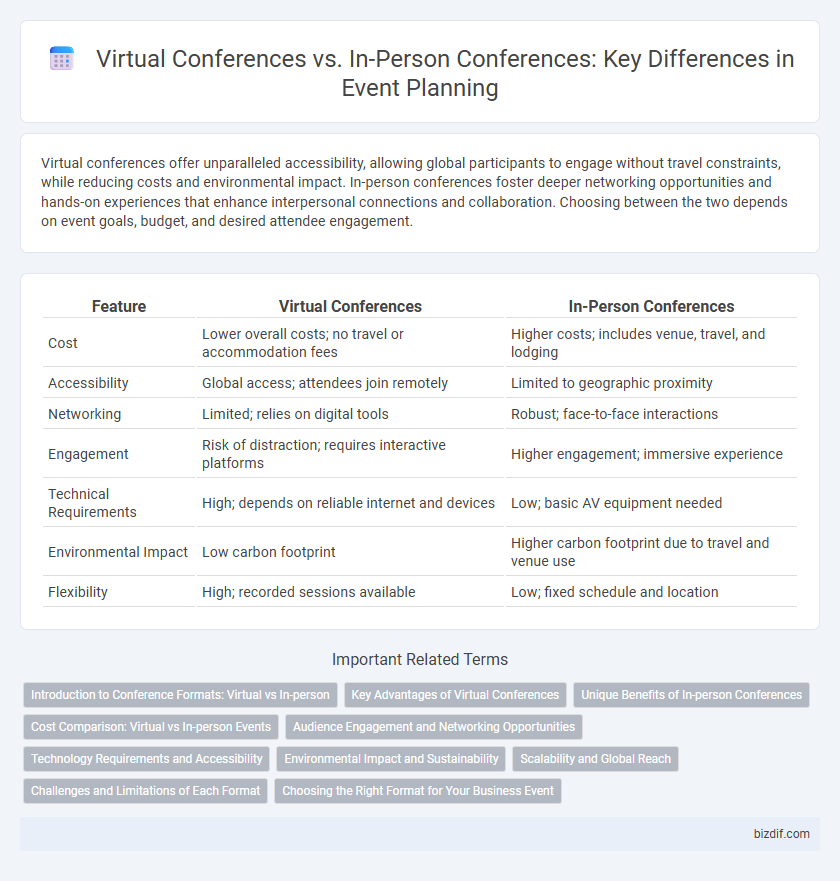Virtual conferences offer unparalleled accessibility, allowing global participants to engage without travel constraints, while reducing costs and environmental impact. In-person conferences foster deeper networking opportunities and hands-on experiences that enhance interpersonal connections and collaboration. Choosing between the two depends on event goals, budget, and desired attendee engagement.
Table of Comparison
| Feature | Virtual Conferences | In-Person Conferences |
|---|---|---|
| Cost | Lower overall costs; no travel or accommodation fees | Higher costs; includes venue, travel, and lodging |
| Accessibility | Global access; attendees join remotely | Limited to geographic proximity |
| Networking | Limited; relies on digital tools | Robust; face-to-face interactions |
| Engagement | Risk of distraction; requires interactive platforms | Higher engagement; immersive experience |
| Technical Requirements | High; depends on reliable internet and devices | Low; basic AV equipment needed |
| Environmental Impact | Low carbon footprint | Higher carbon footprint due to travel and venue use |
| Flexibility | High; recorded sessions available | Low; fixed schedule and location |
Introduction to Conference Formats: Virtual vs In-person
Virtual conferences offer enhanced accessibility and cost-efficiency through online platforms, enabling global participation without travel constraints. In-person conferences provide immersive networking experiences and hands-on interactions that foster deeper connections and spontaneous collaboration. Choosing between virtual and in-person formats depends on event goals, audience preferences, and logistical considerations to maximize engagement and value.
Key Advantages of Virtual Conferences
Virtual conferences offer significant cost savings by eliminating travel, accommodation, and venue expenses while increasing accessibility for a global audience. They enable real-time data collection and analytics, enhancing attendee engagement through interactive tools like polls, Q&A sessions, and chat features. Virtual platforms provide scalability and flexibility, allowing organizers to host larger events without physical space constraints and adapt content delivery to diverse time zones.
Unique Benefits of In-person Conferences
In-person conferences offer unparalleled opportunities for spontaneous networking and face-to-face interactions, fostering deeper relationships and trust among attendees. The immersive environment enhances engagement through hands-on workshops, live demonstrations, and real-time feedback, which are often limited in virtual settings. Additionally, physical presence allows for sensory experiences and social cues that significantly improve communication and collaboration during events.
Cost Comparison: Virtual vs In-person Events
Virtual conferences typically incur lower costs than in-person conferences due to the elimination of venue rental, travel, accommodation, and catering expenses. Technology investments for virtual events, including platform licensing and technical support, represent a smaller portion of the budget compared to the comprehensive logistics costs of physical gatherings. Budget analysis consistently shows virtual events as a cost-effective solution for large-scale attendance without sacrificing engagement.
Audience Engagement and Networking Opportunities
Virtual conferences offer interactive tools such as live chats, polls, and breakout rooms that enhance audience engagement in real-time, enabling global participation without geographical constraints. In-person conferences foster deeper networking opportunities through face-to-face interactions, informal conversations during breaks, and immersive experiences that virtual platforms struggle to replicate. Both formats require strategic planning to maximize attendee interaction and build meaningful professional connections.
Technology Requirements and Accessibility
Virtual conferences require robust internet connectivity, high-quality streaming platforms, and user-friendly interfaces to ensure seamless participation, while in-person conferences depend on physical venues equipped with audiovisual technology. Accessibility for virtual events is enhanced through features like live captions, multilingual support, and on-demand content, making them more inclusive for remote attendees. In contrast, in-person conferences may face limitations in accessibility due to geographical barriers and physical disabilities, despite offering direct networking opportunities.
Environmental Impact and Sustainability
Virtual conferences significantly reduce carbon emissions by eliminating travel-related transportation and minimizing resource consumption tied to physical venues. In-person conferences, while offering direct networking opportunities, contribute to higher environmental footprints through energy usage, waste generation, and accommodation demands. Embracing virtual formats supports sustainability goals by lowering overall ecological impacts and promoting greener event management practices.
Scalability and Global Reach
Virtual conferences offer unmatched scalability and global reach by enabling unlimited attendance without geographical constraints, making it easy to connect participants worldwide. In-person conferences face physical limitations such as venue capacity and travel logistics, which restrict the number of attendees and reduce international accessibility. Leveraging digital platforms, virtual events enhance inclusivity and audience diversity while significantly lowering costs associated with travel and accommodation.
Challenges and Limitations of Each Format
Virtual conferences face challenges such as technical difficulties, limited networking opportunities, and reduced attendee engagement due to screen fatigue. In-person conferences require significant logistical coordination, high costs, and can pose accessibility issues for remote participants. Both formats struggle with maintaining attendee interaction, but virtual events often lack the personal connection while in-person events demand greater investment in time and resources.
Choosing the Right Format for Your Business Event
Selecting the appropriate format for a business event depends on factors such as audience reach, engagement levels, and budget constraints. Virtual conferences offer cost-effective solutions with global accessibility and data-driven insights, while in-person conferences provide deeper networking opportunities and immersive experiences. Evaluating attendee preferences, technological infrastructure, and event objectives ensures the chosen format maximizes impact and ROI.
Virtual conferences vs In-person conferences Infographic

 bizdif.com
bizdif.com